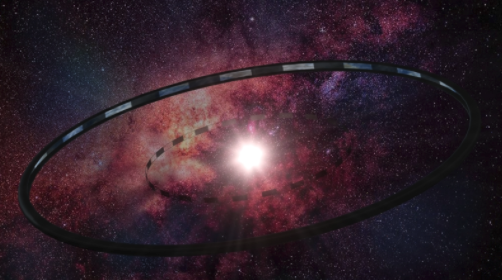
Fact, Fiction, or Future: The Ringworld Hypothesis
“They call it Halo.” -Captain Keyes, Halo: Combat Evolved
Article Header
« Return to Main PageFact, Fiction, or Future: The Ringworld Hypothesis
“They call it Halo.” -Captain Keyes, Halo: Combat Evolved
Introduction
It has been called the game that sold the Xbox. When it released, Halo: Combat Evolved revolutionized the modern first person shooter genre and set the benchmark for many games that would follow. The titular “halo” of the name comes from a massive space station that is the setting of the game. It is a megastructure shaped like a giant wedding ring. Halo with its grand scale, earthlike climate, and aura of mystery is one of the most familiar fictional locations of all time. However, is this just fiction? Could we build a halo ring?
The Definition of BIG
Halo is by definition a megastructure. Standing at more than 2,700 feet high (828 meters), the Burj Khalifa is tallest building ever built. By comparison, the diameter of a halo ring is 10,000 kilometers. That’s more than 10 times the length of Burj Khalifa! In fact, the diameter of earth is only about 12,200 kilometers. If built, halo would be the largest manmade structure ever built. However, even the halo ring is tiny compared to where its inspiration came from.
One Ring to Rule them All
In 1970, science fiction author Larry Niven published a book called Ringworld. It detailed the discovery and exploration of a giant and mysterious ring hovering in intergalactic space. Sound familiar? The novel went on to win the Nebula Award for Best Science Fiction Novel and the Hugo and Locus rewards respectively. Ringworld is considered one of the hallmarks of that era of science fiction. The ringworld or “Niven Ring” as it is sometimes called has “a radius of 93 million miles—the sun-Earth distance—with the sun placed at the center” (Hadhazy, “Could We Build a Ringworld?”). Ringworld’s radius is just shy of 75,000 kilometers. This would be the ultimate space habitat and would take more resources than exist in our entire solar system. As a prequel to our discussion of the halo ring, we will spend some time analysing its predecessor. Several aspects of the Niven Ring will carry over into Halo.
Ringworld Science 101
Niven’s ringworld is a daunting endeavor. It is so large the shear strain on the structure itself should cause it to be torn apart. Several ideas have been proposed to fix this problem. However, that goes beyond the confines of our discussion. For the purpose of this article, we will assume an advanced material could be used to build the Ringworld; in fact, Niven himself created the fictional material “scrith” to explain away the stress. This may seem like a copout, but remember with the advance of the technology and the exponential growth of knowledge such materials could very possibly be created in the future.
For humans to live anywhere comfortably, they require gravity. Most places in our solar system do not have earth-like gravity. This is one of the biggest concerns for long term space travel; gravity is vital to a person’s health. Astronauts that spend any length of time in space are required to have daily exercise in an attempt to counteract the muscle and bone decay caused by zero gravity. There are only two ways (sorry, antigravity really is fiction) currently known that would allow us to generate artificial gravity in space: by spinning a big enough object or forward motion. Since we don’t want the Ringworld to fly across the galaxy (just imagine the parking tickets), we will spin the Ring to create gravity, but how fast?
“To get Earth-like gravity, the Ringworld would need to spin at nearly three million miles per hour” (Hadhazy, “Could We Build a Ringworld?”). That is an immense amount of speed! To put it in perspective, that’s about 1,500 times faster than a bullet! The casual reader is currently thinking: no way! Well, remember where the ring is: space. The vacuum of space (or the void for you sci fi fans!) doesn’t create very much friction. If you started slowly, it is actually possible to spin a large object that fast if you give it enough time. Ringworld itself would only rotate about 73 times in a year despite the speed at its edge. However, this brings up a second problem: the Ringworld’s sun.
Resting in the middle of the Niven Ring is a sun. This allows for the day and night cycles and provides power to the ring. However, the Ringworld does not actually orbit its sun. This means it is not very stable. This was probably the biggest flaw of Niven’s first book, a fact that was pointed out to him so much that he fixed it in the book's sequel, The Ringworld Engineers. If the ring’s distance from the sun is not periodically adjusted to maintain the same distance at every point on the ring, it would fall into the sun. Poof! There goes an astoundingly expensive structure not to mention the deaths of trillions of people! Niven solved this problem by attaching large rockets at various points on the Ringworld to adjust the distance and keep the ring stable. This is not unlike what NASA currently does with International Space Station (which by the way is the largest object built by man in space). Small thrusters must periodically fire in order to keep the station's orbit from decaying. This is a well tested solution to this problem and would allow the Niven Ring to have stability. But what about an atmosphere?
In his novel, Niven postulated that the Ringworld would have walls a thousand miles high on the edges. This would allow for an atmosphere without even needing a roof! “A home in space need not be the enclosed volume usually described in most movies, books and articles. If a strong enough material is used, a rotating cylinder can be so large that it holds an entire atmosphere against its inner surface” (Bishop, “Open Air Space Habitats”). Think of the Niven ring as a slice of this giant cylinder. However, the wall does not actually need to be 1,000 miles high; a wall only “200 kilometers” (Bishop, “Open Air Space Habitats”) or less than 130 miles will work just as well.
Niven’s Ringworld is vastly more impressive than Halo, but as such it is also the least like of the two to be built. However, many of its caveats carry over to the science of the Halo Ring.
Halo Science 101
The construction of a Halo Ring has many similarities with that of the Ringworld except for one detail: it’s much smaller. That is, small compared to a Niven Ring. This means that we don’t have to invent a new material to hold it together; steel or carbon nanotubes will do just fine. A carbon nanotube is made out of the same material as a pencil you might find in your desk. However, carbon nanotubes have a different structure on the molecular level. They look like...wait for it...tubes! Hence the name, carbon nanotubes. This material is ridiculously strong and puts common building materials like steel to shame. It’s major drawback is that each nanotube is tiny. Currently scientists are developing ways to mass produce this substance, but until then steel will serve our purposes for the Halo Ring.
Like the Niven Ring, Halo has to have gravity for healthy human habitation. However, it is also much smaller. To simulate earth’s gravity, “Halo would rotate once every hour and fifteen minutes, or 19½ times a day” (Grazier, “Halo Science 101”). One thing that wasn’t mentioned before when relating to gravity is how weapons work.
The game is famous for its guns, but scientifically they don’t work right. Due to the spin, the bullets or rockets would actually curve (probably missing their target). This phenomenon is known as the Coriolis Effect. Lasers would not be affected by this because of their speed, but you would need a computer to correct the bullet trajectory. This is hard but not impossible. In fact, the United States military is actually in the process of developing “smart” rounds for combat use. It is not far fetched to assume that, if we can build a Halo Ring, we can build the guns that work on them.
To hold in the atmosphere, we will use the same technique as before, walls 200 kilometers high. However, we do have to change something in regards to orbit. The Halo Ring does not have a sun in the middle. Therefore, it needs to orbit something. In the game, Halo orbits around a gas giant similar to Jupiter but larger. For our discussion, we will assume it orbits the earth. For the ring to be stable, it should be placed at a Lagrange Point.
Image Courtesy of Ottisoft.com
“A Lagrange point is a location in space where the combined gravitational forces of two large bodies, such as Earth and the sun or Earth and the moon, equal the centrifugal force felt by a much smaller third body. The interaction of the forces creates a point of equilibrium where a spacecraft” or Halo Ring “may be ‘parked’ to make observations” (Howell,“Lagrange Points: Parking Places in Space.”). If placed at one the these points, the Halo Ring would be relatively stable.
Conclusion
Both Halo and the Niven Ring are considered to be within the “hard” science fiction realm. This means that both of them strive for scientific realism. Niven demonstrated this many times by fixing his novels in order for the science to be right. So will a Halo Ring ever be built? It is not impossible, but consider the cost. A Halo Ring could be built if it was needed, but currently it is not. Who knows? Maybe someday if humanity goes out to explore the stars, we’ll see Halo Rings pop up. But always remember, God has created this world for the human race. It has everything we need, and God has promised to sustain it. So while you're musing about building Halo Rings, remember God’s goodness to you and me, and His marvelous earth that He created. Truly, He is the greatest designer of all.









